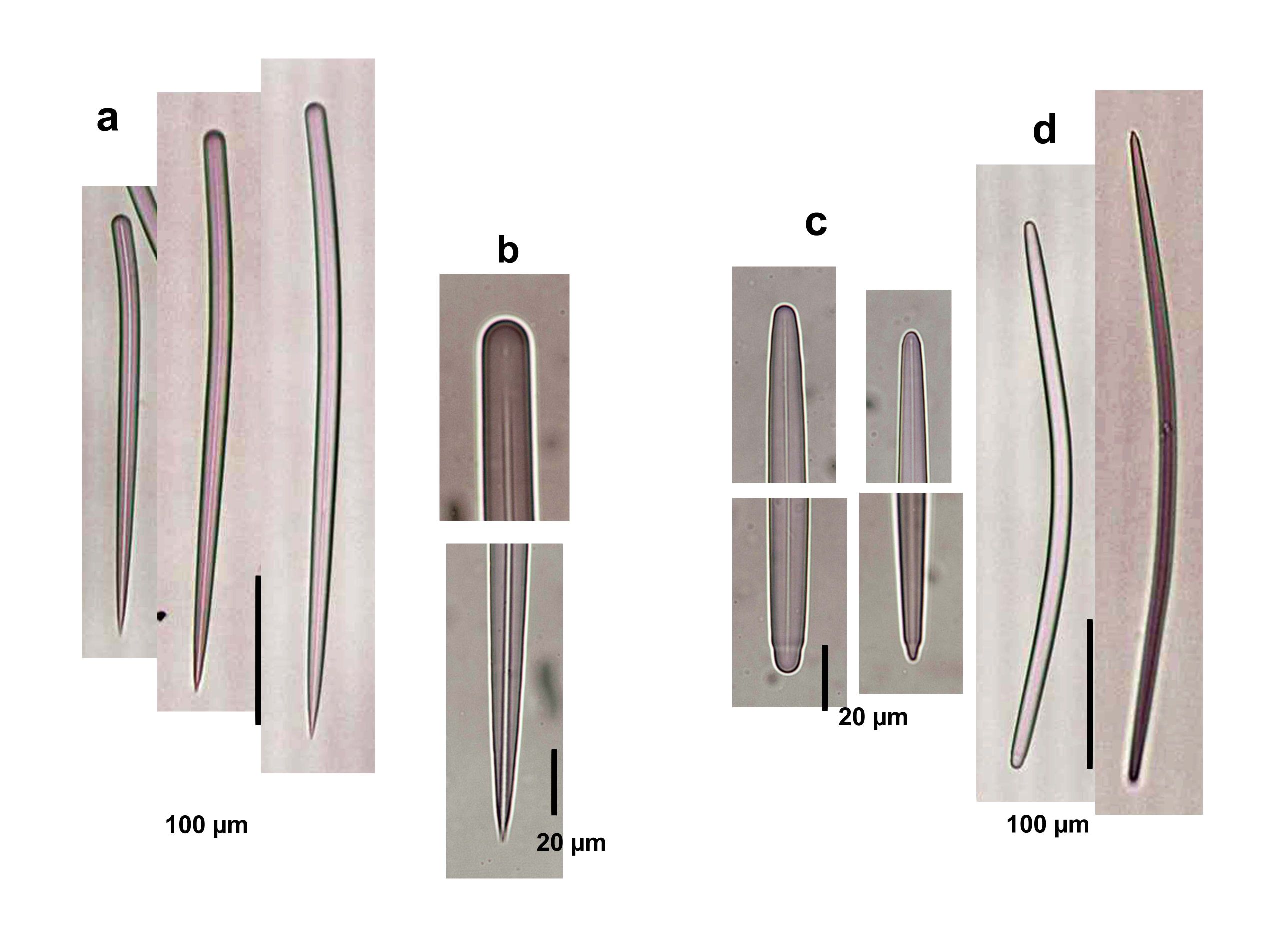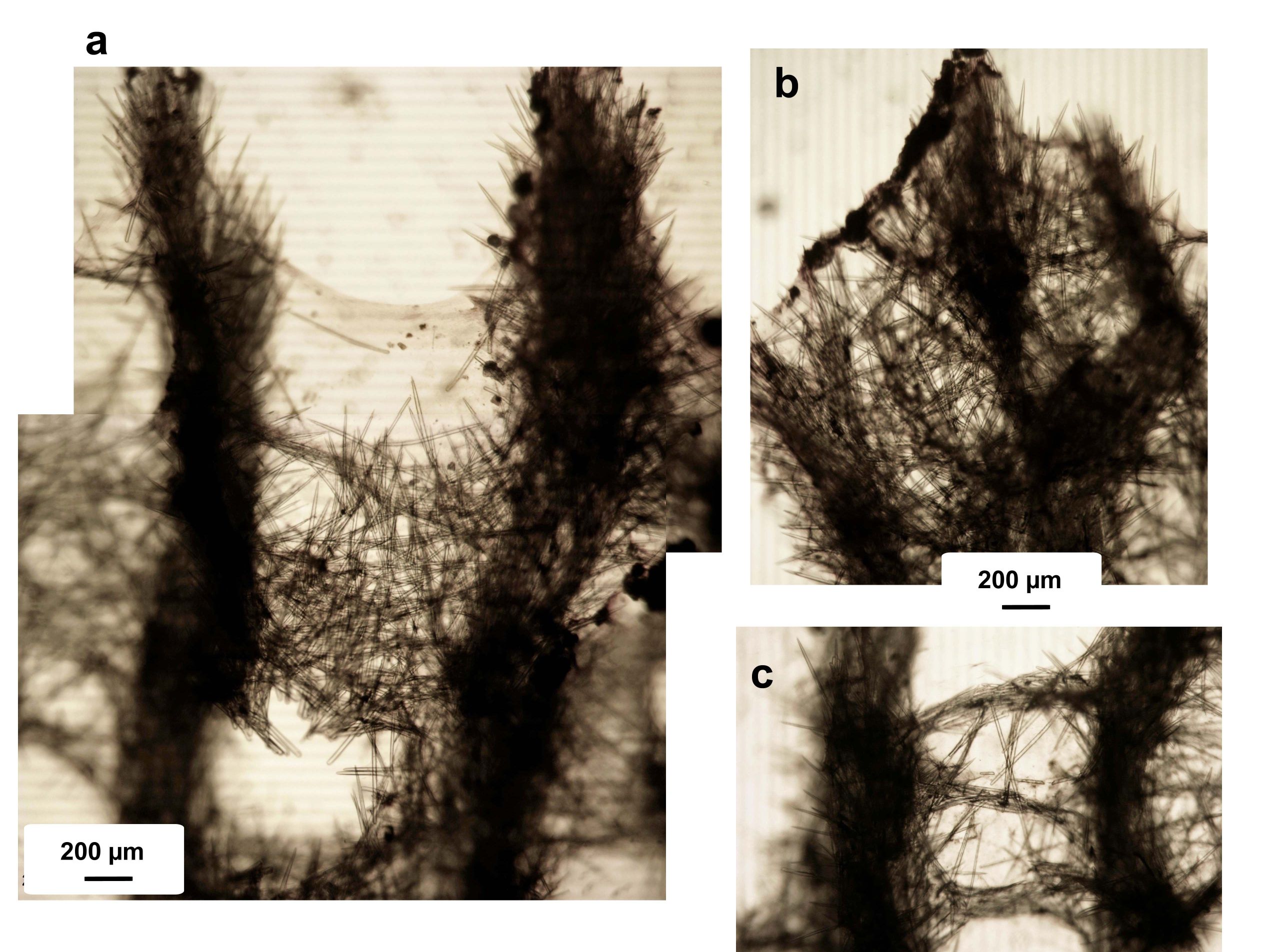the Sponge Guide - www.spongeguide.org
Observed Characteristics:
red
orange
bushy
encrusting
lobate
massive
crumbly
tough
Bahamas
Colombia
Species Description and Notes
Description: Thick encrustations, with low or tall volcano-like elevations containing the oscules, which have a wide rim and are often partly or totally closed by a diaphragm Size up to 10-20 cm in diameter, 1-5 cm thick. Surface strongly spined or with a honeycombed pattern of ridges. Color bright orange or red. Consistency firm, breaks when forced. Specimens release mucus when handled. Skeleton as ascending and diverging thick columns made of packed spicules, 225-500 µm wide, separated 375-1,000 µm, interconnected every 500-1,750 µm by spicule tracts 75-500 µm wide, or by sheets of confusedly arranged spicules, up to 1,500 µm wide. Ascending columns project and open over the surface forming the spines. Spicules are: (1) curved styles with smooth heads and acute ends, 260-450 µm long by 5-17.5 µm wide; (2) curved, hastate oxea, with blunt ends, usually slightly asymmetric, 315-470 µm long by 7.5-15 µm thick.
Notes: This is a shallow to deep reef species, living both exposed and in overhanging substratum. It was originally described under genus Axinella and then placed under Pseudaxinella (see Alvarez et al., 1998), which was synonymized to Dragmacidon (see Alvarez & Hooper, 2002). In their revision of western Atlantic Axinellidae, Alvarez et al. (1998) considered the existence of only one species of Dragmacidon, D. reticulatum (Ridley & Dendy, 1886). However, we believe that there are two similarly-looking but clearly different species of Dragmacidon that often co-exist. From our examination of the type (BMNH 1887.5.2.11) and other material, this morphotype belongs to the actual D. reticulatum, while the other belongs to a species that falls under D. lunaecharta sensu Wiedenmayer (1977), also pictured here, which we are naming temporarily D. "lunaecharta" while a proper name is defined, because the original belongs to a distinct species from the E. Atlantic (Alvarez et al., 1998).
In comparing what we are describing as D. "lunaecharta" and D. reticulatum the differences are clear. D. reticulatum has a more elaborated surface and is tougher, while D. reticulatum has a smoother surface, is softer and often grows erect. In coexisting specimens (e.g., Stirrups Cays, Bahamas, Santa Marta, Colombia), D. "lunaecharta" has smaller spicules, with the oxea slightly larger than the styles, while D. reticulatum has larger spicules and some of the styles as long as the oxea. The skeleton of D. reticulatum is made of thicker ascending spicule tracts, more widely separated and projecting on the surface as spines. [Note of caution: in a previous edition of this guide, we switched the names for the two morphotypes of Dragmacidon: D. reticulatum for the current D. "lunaecharta" and D. explicatum (Wiedenmayer, 1977) for the actual D. reticulatum (according to Alvarez et al., 1998, and to our examination of types, D. explicatum is a junior synonym of D. reticulatum.)]
Author Reference: (Ridley & Dendy, 1886)
Link: World Porifera Database
Tissue and Spicule Images

Spicule Images: a) Styles; b) ends of styles; c) ends of oxea; d) oxea. Sample from the Bahamas.
Source Specimen: http://www.spongeguide.org/ thumbs/00121/00715.jpg

Tissue Images: a) Perpendicular section perpendicular at the surface; b) magnification at the surface; c) magnification of the choanosome. Sample from the Bahamas.
Source Specimen: http://www.spongeguide.org/ thumbs/00012/00411.JPG
Images
Dragmacidon reticulatum
Location: Bahamas, Stirrups Cays, N Berry Islands
Photographer: Sven Zea
Location: Bahamas, Sweetings Cay
Photographer: Sven Zea
Location: Bahamas, Stirrups Cays, N Berry Islands
Photographer: Sven Zea
Location: Bahamas, Little San Salvador
Photographer: Sven Zea
Location: Bahamas, Little San Salvador
Photographer: Sven Zea
Location: Bahamas, San Salvador
Photographer: Sven Zea
![<i>Dragmacidon reticulatum</i> <br />[Bahamas, Egg Island]](thumbs/00121/00715.jpg)
Location: Bahamas, Egg Island
Photographer: Sven Zea
Location: Bahamas, Stirrups Cays, N Berry Islands
Photographer: Sven Zea
Location: Bahamas, Little San Salvador
Photographer: Sven Zea
![<i>Dragmacidon reticulatum</i> <br />[Bahamas, San Salvador]](thumbs/00025/01016.jpg)
Location: Bahamas, San Salvador
Photographer: Sven Zea
Location: Bahamas, San Salvador
Photographer: Sven Zea
![<i>Dragmacidon reticulatum</i> <br />[Bahamas, Stirrups Cays, N Berry Islands]](thumbs/00034/01155.jpg)
Location: Bahamas, Stirrups Cays, N Berry Islands
Photographer: Sven Zea
![<i>Dragmacidon reticulatum</i> <br />[Bahamas, Stirrups Cays, N Berry Islands]](thumbs/00034/01158.jpg)
Location: Bahamas, Stirrups Cays, N Berry Islands
Photographer: Sven Zea
![<i>Dragmacidon reticulatum</i> <br />[Colombia, Santa Marta]](thumbs/00115/01859.jpg)
Location: Colombia, Santa Marta
Photographer: Sven Zea